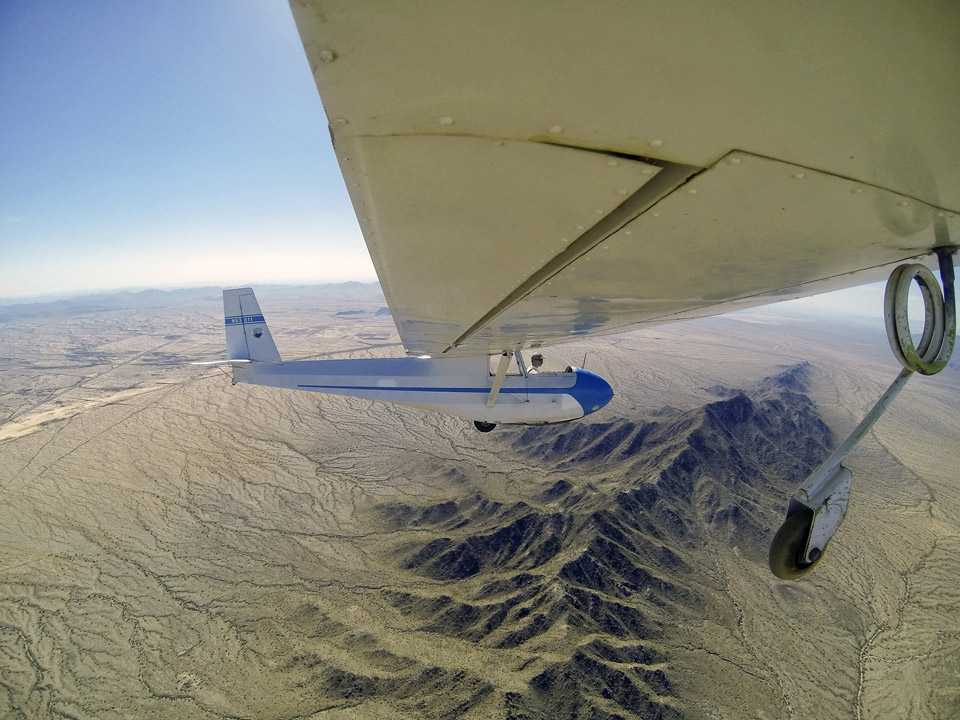
Take a vacation in the southwest with friends and pick up a glider rating in the process. What could possibly go wrong?
The plan: Go to Arizona with friends to earn glider ratings in a week. Fly all day; hangar talk over beer at night. Leave with larger BMIs, smaller bank accounts, and fresh glider ratings.
The reality: five nights of serious studying, four emergencies or urgent situations, two checkrides busted on the first attempt, and one of us bowing out entirely.
And no regrets whatsoever.
Meet the team
Emails to Jason Stephans, owner of Arizona Soaring in Maricopa, Arizona, confirmed that a rating in five days was doable for a current pilot. Of our team, my friends Joel Cutler and Jim Schmidt were the most current, regularly flying their own airplanes. Brandon Seltz had only 120 hours, all logged a couple of years ago, but he flew hang gliders before aircraft and flew simulators for work. I had a commercial ticket and the most flight time, but my currency was wanting.
Joel had started back high enough and flew faster because of the wind. However, even after studying it, none of us really understood how to judge how much faster was enough. Finally, Brandt had to shove the stick forward to make the airport.
“I’d never seen the glider flying that fast,” said Joel. “But now I’ll never forget it.”
The weather relented. I got the rest of my prep flights, and Joel took the test again. We all were on the ground when they rolled to a gentle stop on the last landing. The glider sat in the gravel, balancing on the wheel and nose skid for several seconds before one wing slowly lowered to the ground.
Later Joel told me: “We both sat there perfectly silent, until Terry said, ‘Did you like that one?’”
Final inning
Studying Friday night while Joel and Brandon packed, I said, “I feel like it’s the bottom of the ninth with a man on base and we’re down by one.” After a week of working so intensely together, it was pretty lonely.
Searching for a route to plan my cross-country, I saw an airport named Casagrande. Tom Casagrande was a friend and mentor who died in a Yak-52 crash, but would have loved the idea of a week like this. Zooming in on the chart revealed it was actually Casa Grande, but no matter. That was my route; I would have a friend with me tomorrow.
The oral went three hours, but the Casa Grande route proved perfect for answering the questions tossed my way. The first flight took care of all maneuvers, as well as landing over an obstacle, yet stopping before a mark, and without an altimeter. The next flight was a simulated rope break to a downwind landing, but after the real thing, that was no big deal.
I texted to Joel: “RBI”—runs batted in—and enjoyed that evening beer.
Jeff Van West is a writer and pilot. He is the director of media for Redbird Flight Simulations.
The rope isn't the only weak link
On day one, Jason Stephans said the worst timing for a rope break would be at 100 feet, climbing northbound. It’s too high to land before the gully and trees to the north of the field, but too low to sail over it.
On day two, it happened.
Actually, we were about 75 feet agl—“about” because I was miserably failing to stay in position. Right and high. Left and low. Right and, snap. Over the years, I’ve been front seat for both rough landings and one airplane-totaling crash. This felt more like the crash.
Looking back later while collecting myself (and while minor glider damage was repaired), I realized this was an accident chain where the rope was, quite literally, the final link.
It started the day before when Stephans offered me a solo at 4 p.m. I declined, feeling too spent, but that predisposed him to say the next morning, “Your job is to keep me quiet back here.” He expected solo-level performance and would give me as much, uh, rope as safety allowed.
Now add my inexperience, first flight of the day, first time departing northbound, and first time in that specific glider—which had a center of gravity further aft than the others (I’d later fly it with added ballast). Finally, it was an older rope—retired after this flight. Take out one or two of those and I might have gotten my act together, or Stephans might have intervened, before the break.
Luckily, I had 8,000 hours of accident-chain-breaking experience in the back seat who took over, radically slipped us down, and dug in the nose skid for maximum braking—still thinking to lift a wing over a bush while doing so. —JVW
Batting practice
Stalls and steep turns aren’t that different in a glider, except for keeping track of your glide angle back to the airport. Not so with landing. It starts with an overflight of the airport to check the winds and available runway. First choice is landing on an empty runway; second best is stopping short of another glider that’s also on the runway. This happens often enough, it’s tested on the checkride.
Downwind starts about 1,000 feet agl with 50-percent dive brakes. These lift-spoilers, extending above and below the wing, can increase the Schweizer’s 200-fpm descent to something pretty spectacular without increasing airspeed. On approach, that amount is continuously adjusted to hold a “that looks about right” glide path, heading for the right spot.
The approach feels high and, compared to soaring at 45 mph, fast. But you need that energy for the roundout and flare—occurring only three feet off the gravel. Finally settling onto the monowheel is easy, as extending more dive brakes sheds surplus energy. Rolling along, you work to balance the craft, unicycle-style, until you’re too slow to hold up the wings or nose any longer, or need to brake and stop in a specific spot.
On day one, about to touch down, a thermal lifted us 10 feet back into the air. My instinct was to go around, but in a glider? Stephans closed the dive brakes, nosed down for speed, and pulled us back into a flare with just enough dive brakes to settle.
Murphy threw me two more situations during training. One was a glider getting pulled onto our landing runway moments before touchdown. We closed the dive brakes and floated overhead. The other was a rope break at 75 feet that ended dramatically (see “The Rope Isn’t the Only Weak Link” on page 70).
Game day
Friday opened gray and windy for Brandon’s and Joel’s checkrides. Jim’s instructor Brandt would be Joel’s examiner. Brandon’s examiner arrived with an FAA observer. I overheard questions heavy on regs, and I chided myself for reviewing more general FAR/AIM stuff. Then I left to log more solos to qualify for a commercial ticket on Saturday.
On my second solo, full sideslip wasn’t enough to stay aligned with the runway, forcing me to crab all the way into ground effect. McDonald asked in his open-ended way, “What’d you think about that approach?”—and agreed I should stay on the ground for a while.
Meanwhile, Brandon’s ride ended before they ever left the ground. It felt like having your best batter ejected from the game, and some of the questions seemed ridiculous. What’s VS1 for the Schweizer? Digging into the expanded procedures finally revealed that stall speed goes up three to five mph with full dive brakes. Brandon took it pretty well: “I just drew a bad straw that day.”
About when I realized Joel and Brandt had been gone a long time, they came in low and on a beeline for the runway. Their faces after landing said plainly this was bust number two.
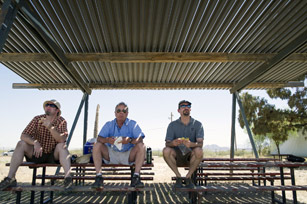 Luckily, our instructors had some experience. Stephans has 4,000 hours in gliders, 4,000 in airplanes, and five aerobatic glider world championships. Our other instructors—Bruce Waddell, James Lyne, and Terry Brandt—had equally impressive (and colorful) backgrounds.
Luckily, our instructors had some experience. Stephans has 4,000 hours in gliders, 4,000 in airplanes, and five aerobatic glider world championships. Our other instructors—Bruce Waddell, James Lyne, and Terry Brandt—had equally impressive (and colorful) backgrounds.
Betty Horvath, who founded the school with her husband in 1969, sold it to Stephans’ father in 1987 and still works the front office. James McDonald, a childhood friend of Stephan’s, helps as a ground handler for the gliders. He’s master observer, asking open-ended questions to help you debug a landing. Yet, he’s not a pilot.
“Part of what was great about this trip was the people at the airport,” Joel told me later. “These aren’t people I meet every day.”
Brandt told us point-blank the schedule was tight, so after basic theory and airport orientation, we got our study assignments and headed out to the Schweizer 2-33.
Training camp
Flying gliders (a.k.a. soaring) is communal by nature. Climbing into the Schweizer requires someone holding down the nose because it sits tail low on one main wheel. It has rollerblade wheels (literally) on the wing tips and tail, as they touch down during takeoff, landing, and ground ops.
After your ground handler connects the towline to your glider and signals the tow pilot to take up slack, he lifts your wing and walks to the tip. The Schweizer now rests on the monowheel—and a beefy metal skid in lieu of a nose wheel. With your ready signal, your wingtip holder becomes your wingtip runner after he signals your last crewmember, the tow pilot, to power up.The metal skid drags across the runway, until you wobble into balance on one wheel. The experience is as satisfying as it is brief.
Then the stick comes forward to stay in ground effect. Lift the 200 feet of towline connecting your nose to the Piper Pawnee’s tail, and you force down his nose. The results would be undesirable, at best.
After trusting us on takeoff, our forgiving tow pilots proceeded to fly at full power and low speed while we learned formation flying on a tether. My breakthrough came when I realized that keeping the towplane on the horizon required anticipatory, small responses similar to those used in precise attitude flying. It was the biggest attitude indicator ever.
Release from tow is one of the most satisfying feelings in aviation. After intense focus, you cut free, turn right, and slow down. It’s a sudden freedom ripe with possibilities. And without headsets or radios, it’s a lot quieter.
Brandon described reaching 9,000 feet on a midweek solo: “It was a magic moment, seeing Phoenix slowly unveil itself from behind the mountains; watching a Southwest flight depart,” he said. “With all the time on the sim, I’ve felt like, ‘Am I a real pilot or just a sim pilot?’ Today was like, ‘No, you’re a real pilot.’”
Evenings and mornings were group study. We puzzled through cross-country planning with overlapping glide cones to different airports; reading polar curves for the best speed to fly with headwinds, tailwinds, and rising or sinking air; and techniques for spiraling in lift or riding the wind off ridges.
Then a shocker: Jim said that even though he loved living and breathing aviation with us, he was stopping. “I really like the landings,” he said. “But the rest, I’m not having fun anymore.” We all understood. This was smart given the trip was a vacation. He promised to come back on Friday to hear how we fared, and we got back in the air.
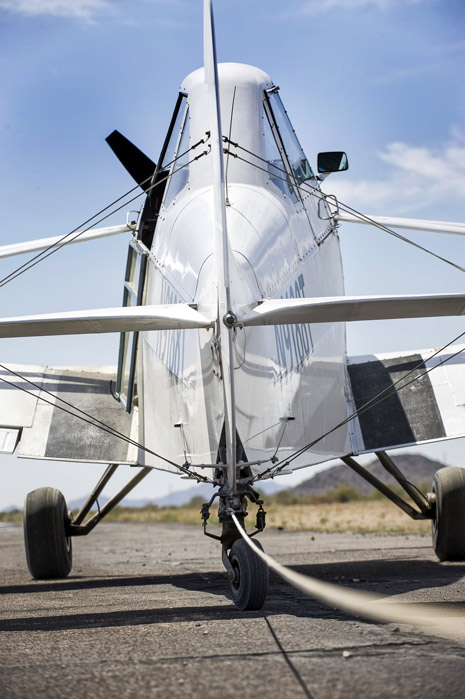
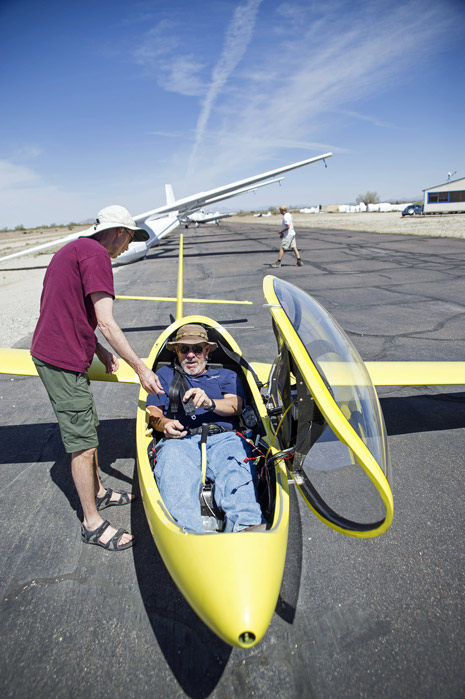
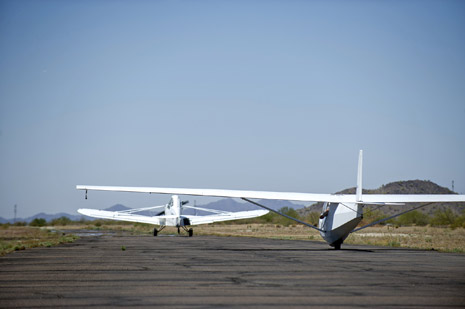
Each day our training 2-33s were lined up like go-carts. Each had our favorites—the author liked the green one.
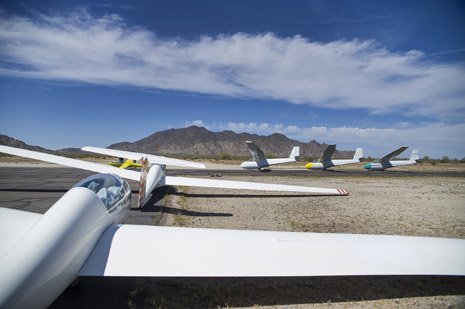
Takeoff in a glider requires staying down in ground effect until the tow plane is airborne and climbing.


